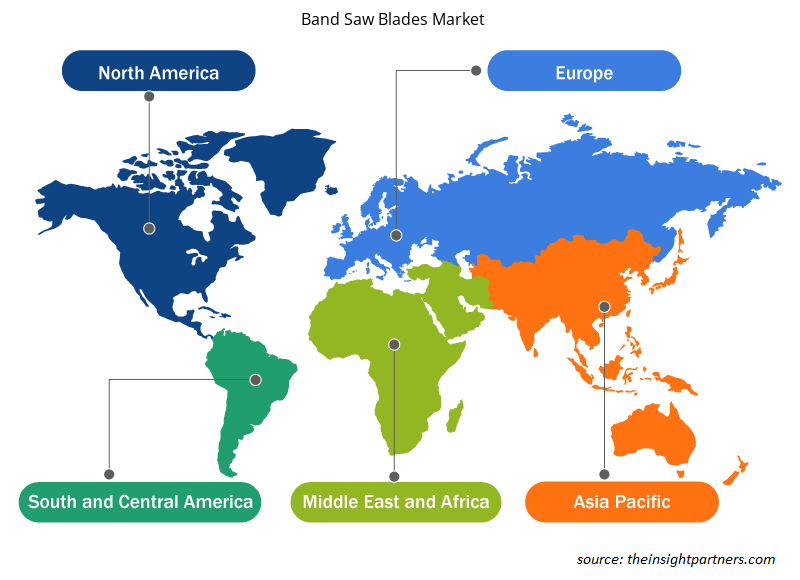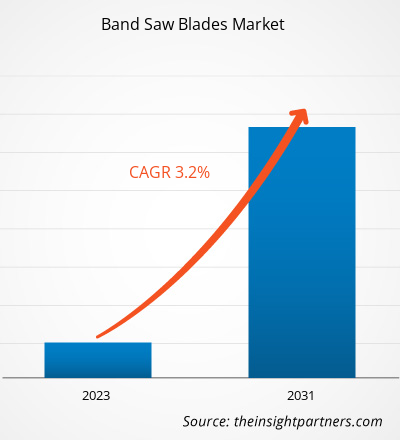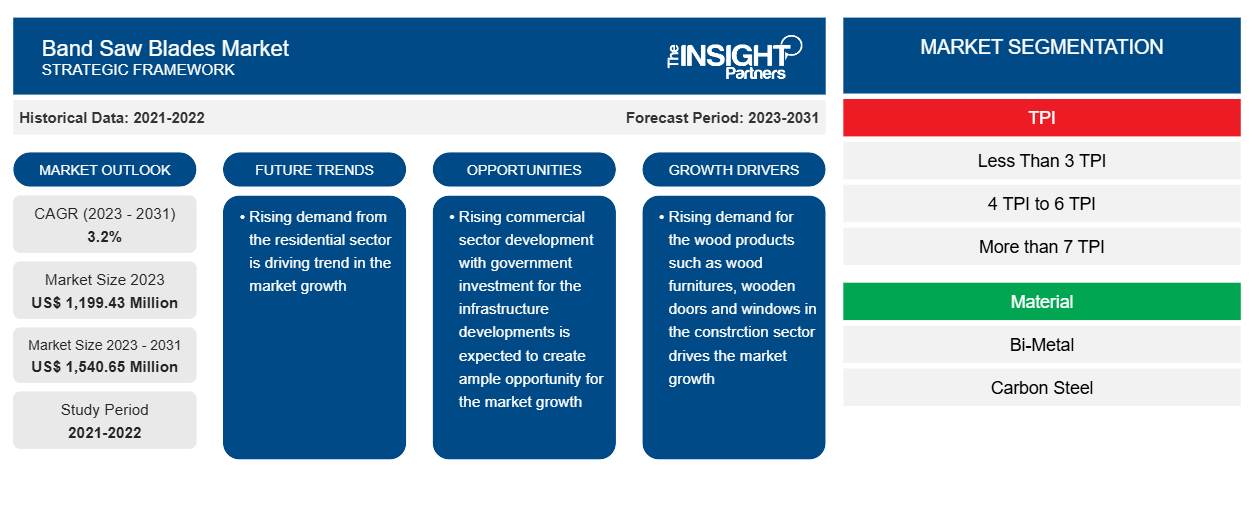Si prevede che la dimensione del mercato delle lame per seghe a nastro raggiungerà 1.540,65 milioni di dollari entro il 2031, rispetto ai 1.199,43 milioni di dollari del 2023. Si prevede che il mercato registrerà un CAGR del 3,2% nel 2023-2031.CAGR of 3.2% in 2023–2031.
Le lame per seghe a nastro trovano applicazioni importanti nei settori della lavorazione del legno e dei metalli, a causa della crescente domanda di lame a denti grossi (2 o 3 TPI) per risegare e tagliare materiali più spessi e lame diamantate o lame ferrose per il taglio dei metalli. I processi importanti nel settore della lavorazione del legno includono la raccolta e la lavorazione del legno e di altre risorse forestali, l'abbattimento di alberi, la lavorazione del legno e la lavorazione della cellulosa e della carta. Le aziende del settore producono prodotti finiti utilizzati dai settori edile, agricolo e alimentare. Le lame per seghe a nastro vengono utilizzate per eseguire la lavorazione primaria del legno.
Analisi di mercato delle lame per seghe a nastro
Le lame per seghe a nastro sono applicazioni di taglio in diversi settori, tra cui agricoltura, taglio di mobili e fabbricazione di taglio di metalli. Le lame per seghe a nastro sono montate sulla macchina che include ruote e motore. Queste lame per seghe a nastro sono utilizzate per segare e tagliare metalli duri come cobalto, zirconio, nichel, ferro, titanio, legno, asfalti, cemento, marmi, graniti e altri metalli. Queste lame sono resistenti all'usura e alla corrosione, legate con cobalto, nichel e acciaio al carbonio per migliorarne la resistenza.
Panoramica del mercato delle lame per seghe a nastro
Le lame per seghe a nastro sono lame di taglio dentate sostituibili utilizzate in molti dispositivi portatili e utensili elettrici portatili e fissi. L'industria del legno in Europa è una delle industrie degne di nota in quanto genera una parte significativa dell'economia della regione. Le industrie europee del legno includono un'ampia gamma di operazioni a valle, come la lavorazione del legno, settori sostanziali dell'industria del mobile, industrie di produzione e conversione di cellulosa e carta e l'industria della stampa. Secondo i dati forniti da Eurostat nel 2022, il valore aggiunto lordo (VAL) delle industrie del legno nell'UE è stato di 136 miliardi di euro nel 2020, pari al 7,2% dell'intera industria manifatturiera. Nel 2020, il valore aggiunto lordo della produzione di legno e prodotti in legno è stato di 37 miliardi di euro. Il VAL più elevato nelle industrie del legno dell'UE è stato segnalato per la cellulosa, la carta e la produzione di prodotti in carta (34% o 46 miliardi di euro). Le attività di stampa e di servizi correlati alla stampa hanno rappresentato il 16% del VAL dell'industria del legno, mentre la produzione di mobili e la lavorazione del legno e dei prodotti in legno hanno rappresentato ciascuna tra il 23% e il 27%.
Personalizza questo report in base alle tue esigenze
Riceverai la personalizzazione gratuita di qualsiasi report, comprese parti di questo report, o analisi a livello nazionale, pacchetto dati Excel, oltre a usufruire di grandi offerte e sconti per start-up e università
-
Scopri le principali tendenze di mercato in questo rapporto.Questo campione GRATUITO includerà analisi di dati che spaziano dalle tendenze di mercato alle stime e alle previsioni.
Driver e opportunità di mercato per le lame per seghe a nastro
L'aumento dei processi di lavorazione del legno e dei metalli in tutto il mondo stimola la crescita del mercato
Le aziende del settore producono prodotti finiti utilizzati dalle industrie edili, agricole e alimentari. Le lame per seghe a nastro vengono utilizzate per la lavorazione primaria del legno. I progressi nelle tecniche di lavorazione dei metalli hanno aumentato la necessità di attrezzature e utensili che smorzino le vibrazioni e il rumore. Il comfort e la facilità di gestione delle attrezzature sono un fattore importante nella lavorazione dei metalli. Pertanto, vi è una crescente domanda di lame per seghe a nastro durevoli con longevità per prevenire guasti e tempi di fermo. L'aumento del processo di produzione delle macchine CNC rafforza la crescita dell'industria della lavorazione dei metalli. L'avvento della tecnologia CNC, i progressi tecnologici, gli sviluppi innovativi dei prodotti e la crescente domanda di utensili elettrici e macchine robotizzate per la lavorazione del legno sono tra gli altri fattori che alimentano la crescita del mercato delle lame per seghe a nastro. Inoltre, la crescente proliferazione di tecnologie avanzate spinge le vendite di lame per seghe a nastro nei settori del legno e della lavorazione dei metalli.
Gli operatori di mercato con una vasta esperienza nel settore della lavorazione del legno stanno lavorando a stretto contatto con le aziende di lavorazione del legno per sviluppare, modernizzare e automatizzare i loro prodotti e implementare sistemi per controllare la qualità del prodotto e la diagnostica di produzione. Il settore del segmento dell'arredamento registra una crescita significativa. Il mercato dei macchinari per la lavorazione del legno sta vivendo una crescita negli Stati Uniti e in Cina. Altri mercati importanti per il settore della lavorazione del legno includono Giappone, Canada e Germania, che spingono la crescita delle dimensioni del mercato globale delle lame a nastro.
Espansione dei progetti di costruzione nelle economie in via di sviluppo
La domanda di lame per seghe a nastro sta aumentando nelle economie dell'Asia Pacifico, del Medio Oriente e del Sud America per il taglio, l'assemblaggio e la riparazione di strutture in legno e metallo. Nei prossimi anni, si prevede che l'Asia Pacifico guiderà il mercato delle lame per seghe a nastro poiché le vendite delle lame stanno aumentando nella regione a causa del crescente numero di progetti di costruzione. Ad esempio, l'impianto di produzione di chip di Shanghai a Shanghai, in Cina, è uno dei più grandi progetti di costruzione avviati nell'Asia Pacifico durante il primo trimestre del 2022. Si prevede che i lavori di costruzione saranno completati entro il 2024. Analogamente, si prevede che la costruzione di un impianto di confezionamento di wafer da 12 pollici e circuiti integrati a Pechino, in Cina, per soddisfare la crescente domanda di prodotti per circuiti integrati sarà completata entro il 2024. In India, la lavorazione dei metalli sta aumentando a un ritmo rapido per realizzare parti singole, assemblaggi e forme metalliche su larga scala per grandi navi, parti di motori e molti settori di utilizzo finale, il che ha aumentato la domanda di lame per seghe a nastro per la sagomatura, il taglio e l'unione di forme. Inoltre, il paese sta assistendo a un'accresciuta necessità di acciaio dovuta alla crescente domanda da parte dell'industria automobilistica e delle costruzioni e alla crescente attenzione del governo sullo sviluppo delle infrastrutture. Secondo i funzionari del settore, la crescita di progetti dedicati ai corridoi merci, nuovi progetti ad alta e semi-alta velocità e l'approvvigionamento di materiale rotabile aumenterebbero il consumo di acciaio.
Analisi della segmentazione del rapporto di mercato delle lame per seghe a nastro
I segmenti chiave che hanno contribuito alla derivazione dell'analisi di mercato delle lame a nastro sono TPI, materiale e applicazione.
- In base al TPI, il mercato è suddiviso in Meno di 3 TPI, 4 TPI a 6 TPI e Più di 7 TPI. Le crescenti applicazioni di lame da 4 TPI a 6 TPI per il taglio di acciaio dolce o materiale ricotto stanno stimolando la crescita del segmento. Gli operatori di mercato nel segmento da 4 TPI a 6 TPI stanno fornendo una quantità ideale di denti considerando lo spessore della parete per eliminare l'usura prematura della lama o il guasto del motore. Si prevede che tali fattori stimoleranno la crescita del segmento da 4 TPI a 6 TPI nel mercato globale delle lame a nastro.
- A seconda del materiale, il mercato è diviso in bimetallo, acciaio al carbonio e altri. Tra questi, il bimetallo ha la quota maggiore nel 2023.
- In base all'applicazione, il mercato è segmentato in taglio del legno e lavorazione della carne. Il taglio del legno è il segmento dominante nel 2023 a causa delle crescenti applicazioni nell'arredamento residenziale.
Analisi della quota di mercato delle lame per seghe a nastro per area geografica
L'ambito geografico del rapporto sul mercato delle lame per seghe a nastro è suddiviso principalmente in cinque regioni: Nord America, Asia Pacifico, Europa, Medio Oriente e Africa e Sud America/Sud e Centro America.
Si prevede che il Nord America dominerà il mercato a causa della popolazione in crescita, della crescente capacità di spesa delle persone e della rapida urbanizzazione nei paesi in via di sviluppo in tutta la regione. I produttori di lame per seghe a nastro stanno sviluppando nuovi prodotti che forniscono un taglio di alta qualità per varie applicazioni di taglio dei metalli. La strategia di innovazione del prodotto si concentra principalmente sul miglioramento delle prestazioni e della durata delle lame per il taglio di precisione dei metalli. La forte concorrenza nel mercato del taglio dei metalli è uno dei fattori chiave che incoraggia i produttori ad adottare strategie di innovazione del prodotto. Uno dei principali produttori di seghe a nastro e prodotti per lime manuali è una nuova gamma di lame per seghe a nastro bimetalliche progettate a profondità specifiche per tutte le applicazioni di taglio dei metalli, tra cui taglio generico, taglio di produzione, taglio di acciaio dolce e taglio di tenacità di leghe esotiche.
Approfondimenti regionali sul mercato delle lame per seghe a nastro
Le tendenze regionali e i fattori che influenzano il mercato delle lame per seghe a nastro durante il periodo di previsione sono stati ampiamente spiegati dagli analisti di Insight Partners. Questa sezione discute anche i segmenti e la geografia del mercato delle lame per seghe a nastro in Nord America, Europa, Asia Pacifico, Medio Oriente e Africa e America centrale e meridionale.

- Ottieni i dati specifici regionali per il mercato delle lame per seghe a nastro
Ambito del rapporto di mercato sulle lame per seghe a nastro
| Attributo del report | Dettagli |
|---|---|
| Dimensioni del mercato nel 2023 | 1.199,43 milioni di dollari USA |
| Dimensioni del mercato entro il 2031 | 1.540,65 milioni di dollari USA |
| CAGR globale (2023-2031) | 3,2% |
| Dati storici | 2021-2022 |
| Periodo di previsione | 2023-2031 |
| Segmenti coperti |
Di TPI
|
| Regioni e Paesi coperti |
America del Nord
|
| Leader di mercato e profili aziendali chiave |
|
Densità degli attori del mercato: comprendere il suo impatto sulle dinamiche aziendali
Il mercato delle lame per seghe a nastro sta crescendo rapidamente, spinto dalla crescente domanda degli utenti finali dovuta a fattori quali l'evoluzione delle preferenze dei consumatori, i progressi tecnologici e una maggiore consapevolezza dei vantaggi del prodotto. Con l'aumento della domanda, le aziende stanno ampliando le loro offerte, innovando per soddisfare le esigenze dei consumatori e capitalizzando sulle tendenze emergenti, il che alimenta ulteriormente la crescita del mercato.
La densità degli operatori di mercato si riferisce alla distribuzione di aziende o società che operano in un particolare mercato o settore. Indica quanti concorrenti (operatori di mercato) sono presenti in un dato spazio di mercato in relazione alle sue dimensioni o al valore di mercato totale.
Le principali aziende che operano nel mercato delle lame a nastro sono:
- BAHCO (SNA Europa)
- Gruppo di acciaio speciale Dongbei Co., Ltd.
- Friedrich Bickenbach GmbH & Co.
- KG
- Gi-Esse Salvador Srl
- HABUR-SAWS GmbH
Disclaimer : le aziende elencate sopra non sono classificate secondo un ordine particolare.

- Ottieni una panoramica dei principali attori del mercato delle lame per seghe a nastro
Notizie di mercato e sviluppi recenti sulle lame per seghe a nastro
Il mercato delle lame per seghe a nastro viene valutato raccogliendo dati qualitativi e quantitativi dopo la ricerca primaria e secondaria, che include importanti pubblicazioni aziendali, dati associativi e database. Di seguito è riportato un elenco degli sviluppi nel mercato per innovazioni, espansione aziendale e strategie:
- Diablo Tools ("Diablo"), che offre una gamma orientata alle soluzioni di prodotti best-in-the-world e best-for-our-world per l'utente professionale, introduce un'altra novità assoluta nel mercato degli utensili multiuso oscillanti ("OMT"): la lama AMPED™ Demo Demon™ Carbide Teeth Blade for Nail-Embedded Wood. Questa lama OMT in carburo, la prima nel suo genere, è progettata specificamente per il legno con chiodi incorporati e offre vantaggi specifici per l'applicazione e innovazioni rivoluzionarie per i professionisti. (Fonte: comunicato stampa aziendale, aprile 2024)
- La divisione sussidiaria di KR Saws Roentgen, un rinomato leader tedesco nelle soluzioni di taglio industriale, ha svelato la sua ultima innovazione su misura per la segatura di leghe a base di nichel. Le lame per seghe a nastro Roentgen Fit Set e Fit sono state progettate e prodotte per migliorare le prestazioni di taglio, prolungare la durata dell'utensile ed eliminare la necessità delle tradizionali procedure di rodaggio, risparmiando in definitiva tempo e risorse preziose per i produttori e gli ingegneri di metalli. Le leghe a base di nichel come Inconel 718 e 625 sono note per la loro eccezionale resistenza, resistenza alla corrosione e proprietà ad alta temperatura e sono difficili per gli utensili da taglio convenzionali. (Fonte: comunicato stampa aziendale, marzo 2024)
Copertura e risultati del rapporto di mercato sulle lame per seghe a nastro
Il rapporto "Dimensioni e previsioni del mercato delle lame per seghe a nastro (2023-2031)" fornisce un'analisi dettagliata del mercato che copre le seguenti aree:
- Dimensioni e previsioni del mercato delle lame per seghe a nastro a livello globale, regionale e nazionale per tutti i segmenti di mercato chiave coperti dall'ambito
- Dinamiche di mercato come fattori trainanti, vincoli e opportunità chiave
- Tendenze del mercato delle lame per seghe a nastro
- Analisi PEST dettagliata e analisi SWOT
- Analisi di mercato delle lame per seghe a nastro che copre le principali tendenze del mercato, il quadro globale e regionale, i principali attori, le normative e i recenti sviluppi del mercato.
- Lame per seghe a nastroPanorama del settore e analisi della concorrenza che copre la concentrazione del mercato, l'analisi della mappa di calore, i principali attori e gli sviluppi recenti.
- Profili aziendali dettagliati
- Analisi storica (2 anni), anno base, previsione (7 anni) con CAGR
- Analisi PEST e SWOT
- Valore/volume delle dimensioni del mercato - Globale, Regionale, Nazionale
- Industria e panorama competitivo
- Set di dati Excel
Report recenti
Testimonianze
Motivo dell'acquisto
- Processo decisionale informato
- Comprensione delle dinamiche di mercato
- Analisi competitiva
- Analisi dei clienti
- Previsioni di mercato
- Mitigazione del rischio
- Pianificazione strategica
- Giustificazione degli investimenti
- Identificazione dei mercati emergenti
- Miglioramento delle strategie di marketing
- Aumento dell'efficienza operativa
- Allineamento alle tendenze normative























 Ottieni un campione gratuito per - Mercato delle lame per seghe a nastro
Ottieni un campione gratuito per - Mercato delle lame per seghe a nastro